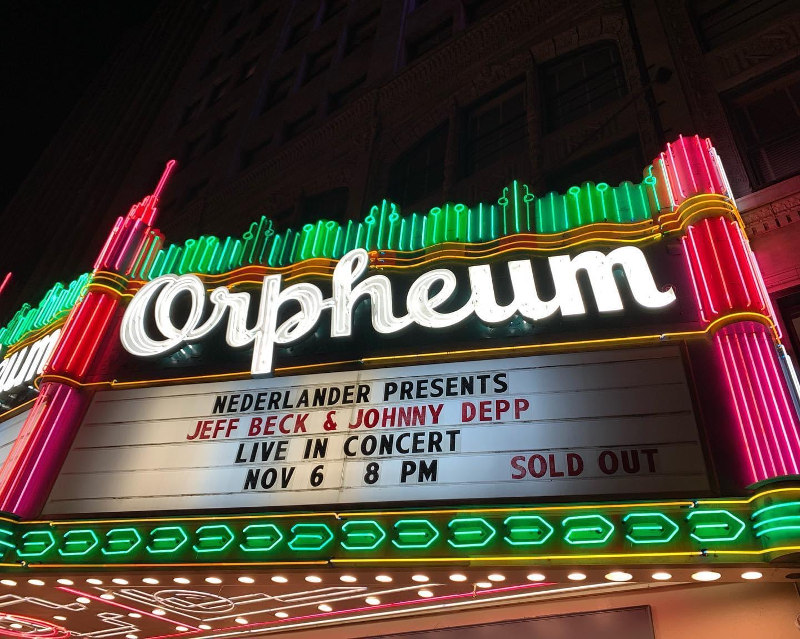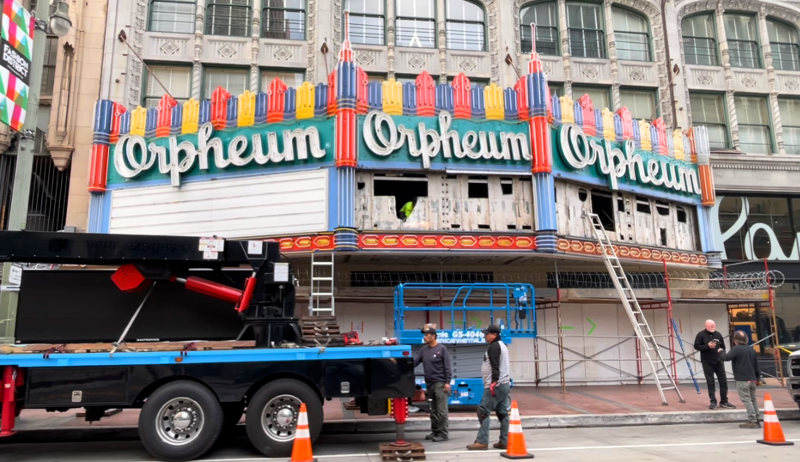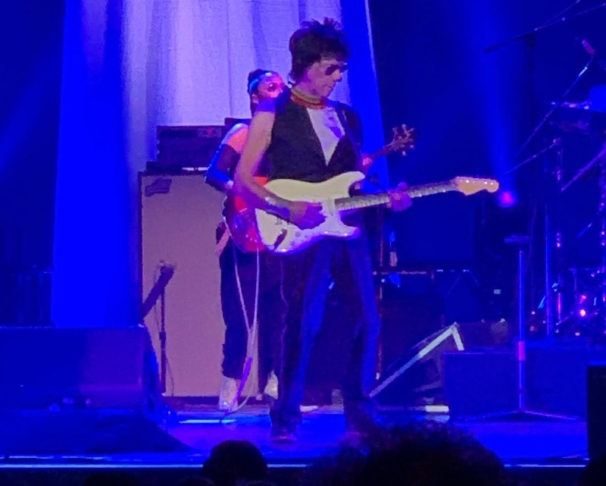
ed. note: The heartbreaking and unwelcome news of the death of legendary rock guitarist, Jeff Beck, sent us careening to an earlier time and place. But for a theater full of his Los Angeles fans, that time and place was the Orpheum Theatre just two months ago, where on November 6, 2022, they saw him perform. In that crowd was a Friend of Arts Meme (F.O.A.M.) Jeff Mantor, the proprietor of Larry Edmunds Book Shop in Hollywood. Mr. Mantor revealed in a Facebook post that he was actually named for Jeff Beck by his rock-loving father. So that’s a tough loss on several levels.
But there’s more. In one of those confluences that just makes you feel sick, Jeff Beck’s concert with Johnny Depp would have been among the very last to be featured on the Orpheum’s iconic marquee. You know … when you’re driving the streets of Los Angeles, and there’s a little guy on a very big stepladder risking his neck to swap out an alphabet soup of letters to create a movie marquee? Another F.O.A.M, Chris Nichols, has let us know, in distress, that the Orpheum, a most prominent member of the so-called National Registry district of Downtown Los Angeles theaters, seems to have tired of that task. The Orpheum is in the midst of destroying the panels that allow for changeable lettering, to be replaced with grotesque LED flashing things that, among other distractions, add to the city’s already insuperable light pollution. Chris’s informational letter reprinted here. If you want to get involved write to askchris@lamag.com . Details below.

Letter from Chris Nichols below:
A current construction project is changing the marquee of downtown’s Orpheum theater from a traditional backlit sign with changeable letters, to an LED screen. This building is a contributor to a National Register district, AND has a conservation easement held by the Los Angeles Conservancy, which has reviewed and approved the modification.
I believe that these changes violate The Secretary of the Interior’s Standards and harm this historic resource. Historic signs are a highly endangered resource and their preservation requires further study. This approval demonstrates a lack of understanding of what makes a historic sign important. Nobody in historic preservation would allow stone gargoyles to be replaced by vinyl replicas, or install LED screens in place of stained glass, and yet historic signs suffer these indignities.
I was at the Chinese Theater this weekend and saw endless billboard ads flash by where their marquee once stood. The rooftop neon sign at the Hollywood Roosevelt also flashed video advertising after its readerboard was replaced with a video screen a few years ago. This same fate has befallen the Ritz, Vogue, and Hollywood theaters nearby. This character destroying feature has not yet come to Broadway, but could endanger the United Artists, Million Dollar, and Palace theaters, which currently have changeable letter signs.

The Conservancy notes that changeable letter panels can be installed over the new screen, but that is a laborious and expensive process that will likely only be undertaken for big budget movie filming. Once this goes, it will not be coming back. The panels are already down. These screens start as marquees but often evolve into outdoor advertising. Billboards. Continued loss of historic elements on protected buildings sets a terrible precedent for the whole city.
Please see below. I believe the Office of Historic Resources and the Los Angeles Conservancy require a better understanding of historic signs and their importance in a city whose history is as defined by car culture as Los Angeles.
1. A property will be used as it was historically or be given a new use that requires minimal change to its distinctive materials, features, spaces and spatial relationships.
The current version of the marquee dates to 1941 and includes a (replica) opaque white plexiglass readerboard with letter tracks designed to be used with vacuum formed, three-dimensional Snap Lok – type changeable lettering. Since 2001, flat lettering has been used in the same basic colors and similar slotting, with a top track, bottom track, and dual track configuration. Plastics were new and modern materials in the 1940s, helpful in projecting a new and modern image for large marquee set at an angle that would be visible to automobile traffic. The distinctive appearance of large and small letters created by the limited alphabet, the spatial relationship of the changeable letter character spacing, and, in its original form, three dimensional characters, are a major character defining feature of theater marquees.
2. The historic character of a property will be retained and preserved. The removal of distinctive materials or alteration of features, spaces and spatial relationships that characterize a property will be avoided.
Removing an analog changeable letter system designed in 1941 and replacing it with a LED motion video readerboard completely changes the historic character of the major character defining feature of the primary elevation. The whole point of a theater marquee is to grab attention, and altering this with very visible 21st century technology will be the loudest, brightest feature of the entire building. It will irrevocably alter the historic character of this property.
3. Each property will be recognized as a physical record of its time, place and use. Changes that create a false sense of historical development, such as adding conjectural features or elements from other historic properties, will not be undertaken.
Replacing the readerboards with LED video screens that can offer motion graphics and video will completely alter the appearance of this 1941 sign. Removing this fabric alters the physical record of its time, place and use.
4. Changes to a property that have acquired historic significance in their own right will be retained and preserved.
The 1941 marquee is a key part of this building, and an exemplary example of neon marquee design, among the best in the city. It maintains a high degree of integrity and has acquired historic significance as an artifact from the heyday of the Broadway theater district.
Jeffrey Mantor is the owner/proprietor of Larry Edmunds Book Shop, a Hollywood book store focused on film and theater history since 1938.
Chris Nichols joined Los Angeles magazine in 2000. He writes the Ask Chris column and brings a historical perspective to the magazine with pieces on lost neon, vintage road trips, and stylish Angelenos living in the past. He has been involved in historic preservation for 25 years working to save the iconic mid-century modern architecture of Los Angeles. His book The Leisure Architecture of Wayne McAllister won the Independent Publishers award in 2008.
